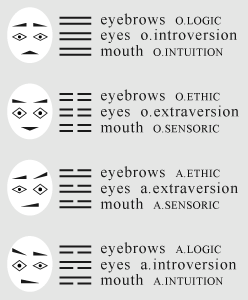-
The analytical physiognomy is a code of knowledge or representations about
ratio of mental functions of brain hemispheres with features of a human face,
and also the analytical physiognomy is a method according to which features of a
human face allow to identify mental functions of a brain, and allow to define
psychological types in a context of analytical psychology of C. G. Yung and and
I. Brigs-Majers's typology.
The basic concepts of analytical physiognomy consist in the following.
Logic function corresponds with left hemisphere of a brain and right eyebrow.
Ethical function corresponds with right hemisphere of a brain and left eyebrow.
Intuitive function corresponds with left hemisphere of a brain and right corner
of a mouth.
Sensory function corresponds with right hemisphere of a brain and left corner of
a mouth.
Logics and ethics as rational mental functions correspond with eyebrows which in
view of physiognomy associate with consciousness and rational perception of the
world.
Intuition and sensorics as irrational mental functions correspond with corners
of a mouth which in view of physiognomy associate with feelings and irrational
perception of the world.
Psychological attributes of introversion correspond with left hemisphere of a
brain and right eye.
Attributes extraversion correspond with right hemisphere of a brain and left
eye.
Namely functions of brain hemispheres are comparable to features of a human
face, but functions of right hemisphere are projected in features of left half,
and functions of left hemisphere are projected in features of right half of a
face.
Ratio of mental functions with facial features in a context of analytical
physiognomy are systematized by means of hexagrams of the canon of changes i-jing,
namely by means of the complex of logic symbols which allow to systematize
psychological types of analytical physiognomy and C. G. Yung's analytical
psychology.
Features of a human face for this purpose are unified and compared to symbols of
the canon i-jing, and in essence physiognomic parameters of mouth corners, and
eyes, and eyebrows are unified by means of 64 physiognomic symbols and compared
to symbols i-jing as shown in the chart.
 |
Top digrams in hexagrams i-jing are compared to
eyebrows which correspond with rational mental functions of logics or
ethics. Middle digrams are compared to eyes which correspond with introversion or extraversion. Bottom digrams are compared to mouth corners which correspond with irrational mental functions of intuition or sensorics. As a result of logic combinations 64 hexagrams of the canon of changes i-jing correspond to 64 psychological types of analytical physiognomy in a context of analytical psychology of C. G. Yung, and in essence correspond to physiognomic symbols which designate symbolical features of a face and correspond with psychological types, that is in detail described on pages of this website in sections which have names the right and left face, and also analytical physiognomy. |
-
Bright expressive eyes correspond to obvious extraversion and
correspond with greater eyes in physiognomic symbols.
Inexpressive eyes correspond to obvious introversion and correspond with
small eyes in physiognomic symbols.
Expressive right eye and inexpressive left eye correspond to active
introversion, that corresponds to the big right eye and small left eye in
physiognomic symbols.
Expressive left eye and inexpressive right eye correspond to active
extraversion, that corresponds to the big left eye and small right eye in
physiognomic symbols.
Equally raised eyebrows correspond to obvious ethical function.
Equally lowered eyebrows correspond to obvious logic function.
Raised right eyebrow and lowered left eyebrow correspond to active logic
function.
Raised left eyebrow and lowered right eyebrow correspond to active
ethical function.
Equally lowered corners of a mouth correspond to obvious intuitive
function.
Equally raised corners of a mouth correspond to obvious sensory function.
Raised right corner and lowered left corner of a mouth correspond to
active intuitive function.
Raised left corner and lowered right corner of a mouth correspond to
active sensory function.
Symbols of analytical physiognomy allow to correlate parameters of human faces
to symbolical parameters and to identify psychological types, and also
physiognomic symbols allow to analyze interrelations of psychological types and
mutual relations of people that is a theme of this section of website.
The following page places hexagrams of the canon of changes i-jing and physiognomic symbols of psychological types of analytical psychology in the ring scheme for analyses of transactions of mental functions in a context of analytical physiognomy.
-